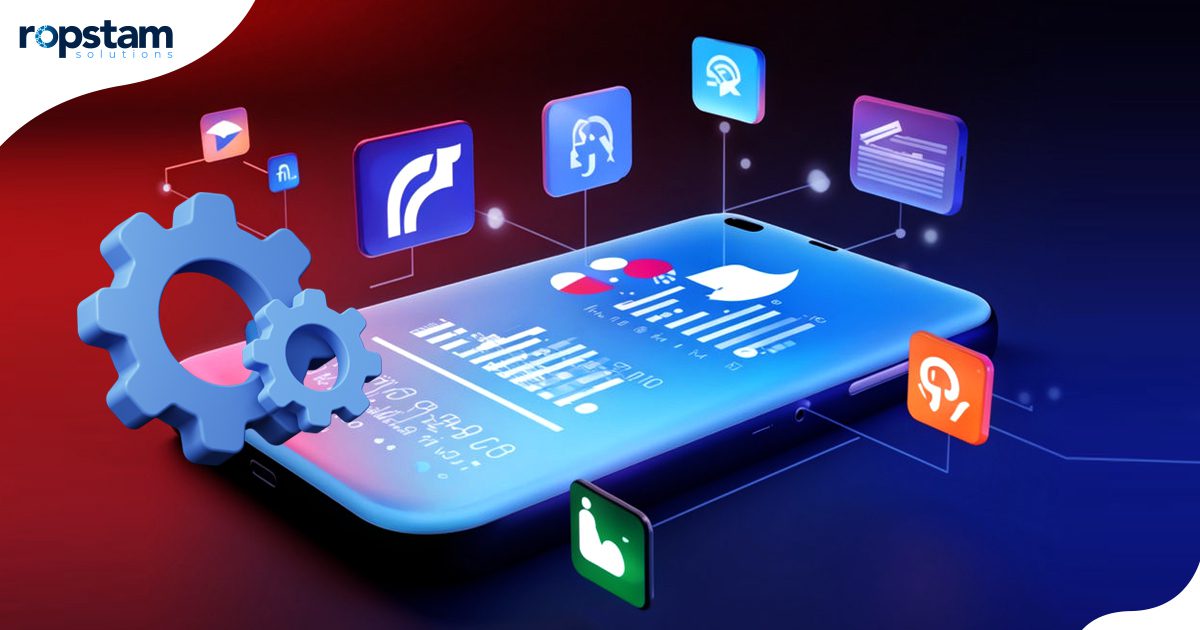Mobile app maintenance is the phase following the application development process and launch, during which native and cross-platform developers ensure the app remains working smoothly, secure, relevant, and enjoyable for users amidst the constantly growing number of users and the evolving technological landscape.
When we talk about mobile application maintenance, it involves checking for bugs and fixing them, monitoring the performance of the app and checking if it is running perfectly or not, ensuring the app is compatible with all mobile operating systems, updating content and security, improving UI/UX for better user experience, renewing licenses for app third party licenses, and regularly testing the application for awesome usability.
Ahead, we have “taken the liberty” to compile a checklist for mobile app updates that can help you chalk out your maintenance plan. This mobile app maintenance checklist is made for your native (Android, Windows, and iOS) and cross-platform mobile applications which include the following tasks:
- Bug fixes
- Performance monitoring
- Ensure system compatibility
- Content updates
- Security updates
- Improve UI/UX
- License renewal
- Mobile app testing
You want to ensure that your mobile application runs smoothly, meets user expectations, and delivers on the premise your business stands by. Here are the most important areas that you need to cover to ensure immaculate app functionality:
Bug fixes
A bug in a mobile application is a defect, error, or flaw in the software that causes the app to behave unexpectedly, incorrectly, or not as intended. Bugs can vary in severity, from minor issues like typos or visual glitches to major problems that hinder the app’s functionality. These should be identified by doing testing and then fixed as soon as possible.
Mobile application performance is reflective of user confidence. Your app performance is as good as your developers’ ability to track down and squash bugs efficiently. Once an application is deployed, after rigorous QA testing, you might assume you have dealt with all possible bug fixes.
However, with time, third-party services used by your application may introduce updates and new features. These can often lead to new bugs and performance issues within your app. Hence, you must regularly re-run QA tests and be on the lookout to track and fix any new bugs.
Performance monitoring
Performance monitoring of a mobile app means to proactively track an app’s behavior and performance metrics in order to identify and solve issues that might affect the user experience.
Monitoring mobile app usage goes beyond just tracking bugs and crashes. Tools like Firebase and New Relic can help you track app performance. The data from effective monitoring can give you insights about your user base.
Performance monitoring lets you track new downloads, app retention, session lengths, etc., for your marketing team. This data can also be further analyzed to help your team develop new features, improve existing functionality, and create a more user-centric experience.
Ensure operating system compatibility
System compatibility in terms of mobile application means that your app functions correctly on a specific version of the platform, typically the latest one. Most major mobile phone operating systems (Windows, iOS, and Android) introduce patch updates throughout the year, with one major version released once every year.
Patch updates include security updates and occasional feature enhancements. You want to ensure that your app is compatible with these updates. And mobile compatibility testing is done for this purpose.
Mobile compatibility testing ensures that a mobile application functions correctly across various mobile devices and operating systems (OS). It verifies that your application will perform as expected on the operating systems and devices of the users.
For major OS releases, the mobile developers can use the beta version of the OS to plan app updates. This allows you to introduce new functionality leveraging the OS updates, test existing features, and fix bugs in advance.
Content updates
Your mobile app’s content is critical to engagement and retention. To stay ahead of the market competition, you want to ensure that everything including content is fresh and up to date in your application.
The mobile app store algorithms also favor apps that get frequent content updates and are most likely to appear within the top search results. Relevant content updates that reflect market demands can be critical to increased engagement for your mobile app.
Security updates
Security updates in the domain of mobile app development are software updates that focus on enhancing security and addressing bugs in the operating systems such as Android, iOS, and Windows. These updates provide the patches or new features designed to fix existing security vulnerabilities and safeguard against potential security threats.
It is crucial that your app feels secure for user confidence. With an ever-growing increase in cyber threats and data leaks, you must check any security vulnerabilities your app may be subject to.
Periodic security analysis and frequent security updates can help ensure your data is not at risk. Security updates often go hand-in-hand with OS and API updates for the services that your app depends on.
Improve UI/UX
UI design in mobile app focuses on how users interact with the app, including elements such as menus, pop-ups, buttons, controls, and other visual components that define the app’s appearance. On the other hand, UX design in mobile application is concerned with crafting a meaningful and relevant experience for the user. This includes aspects like voice recognition, layout, prompts and interactions, navigation, and more.
Like every other type of creative content, experience design in mobile applications is ever-evolving. New trends and design patterns emerge daily, and staying on top of these trends is a great way to keep your users engaged.
With every update you roll out, you can include improvements to your UI/UX design for increased usability. You can also revamp features like app animations and buttons for an improved user experience.
License renewal
Expired or non-renewed licenses can impact app usability or even cause the app to crash. Updating licenses for your third-party services, security certificates, and any third-party content you may be using is essential. Maintain and update your permits promptly to avoid additional costs and technical issues within your app.
Mobile app testing
Mobile app quality assurance (QA) testing is a thorough process dedicated to ensuring that a mobile application meets all predefined quality standards and specifications. This process involves a range of testing and inspection tasks designed to find and correct issues such as inconsistencies and errors that could affect the app’s security, performance, usability, and overall user experience.
Before deploying any mobile app update, the concerned team must perform QA tests. These tests ensure that your app meets all performance benchmarks and that any updates or changes deliver the desired results.
Rigorous testing helps avoid bad user reviews and can decrease the number of patches you might have to roll out for bug fixes and other minor performance issues.
Why is it necessary to maintain a mobile app?
It is very important for mobile application developers to maintain an app, whether Android or iOS. All technologies require periodic maintenance to ensure optimal functionality, comply with industry standards, and stay relevant. Mobile applications are no different. The mobile app industry is ever-changing and evolving, with new UI/UX design patterns and technical updates, such as shifting from 4G to 5G technology.
The work continues once a business successfully launches a mobile app. Ensure that the application stays in the game longer. This entails long-term retention from the customers and compatibility with OS updates.
To cement your place in the market, there must be an extensive maintenance plan in place that covers all possible updates to the mobile app. You want to focus not just on new features and functionalities but also regularly maintain existing features, introduce security patches, and refresh the app design to suit the user base better.
A well-maintained mobile app can be a steady source of revenue and a growing customer base. Here are a few more reasons why app maintenance is essential:
- App retention: App retention reflects how long a user keeps your application installed on their phone. A well-maintained app is more likely to be used, ensuring increased retention.
- ROI: ROI stands for Return on Investment. The better maintained your app is, the more likely you are to see an increase in your ROI.
- Adapting to new technologies: App updates can often be made to accommodate newer technologies, such as introducing 5G support or leveraging a better camera setup in recently released devices.
- Cost efficiency: A well-maintained app helps you reduce additional costs, such as late license renewals or data retrieval costs in case of security breaches.
- Relevance: Staying updated with your app design and content is crucial to maintaining user interest. Doing so also ensures your application is well-ranked within search results.
- Legal compliance: With evolving government regulations, you must ensure that your app complies with updated local, national, and international rules. Regular maintenance ensures your app remains legally compliant, preventing potential legal complications.
Building and deploying the mobile application is only half the work. Maintaining it is the other half and is one of the best practices to follow. Lack of maintenance can adversely impact your mobile application’s performance analytics and user satisfaction rate. This makes all types of mobile app maintenance crucial for maintaining your application’s reputation and ensuring you keep your stronghold within the relevant industry.
What are the types of mobile app maintenance?
Mobile app maintenance is an extensive process and generally falls into one of these four major categories:
- Preventive app maintenance: The developers regularly analyze the app to look for and fix any missed bugs or glitches.
- Predictive app maintenance: Using data gathered based on app usage, developers use the insights to develop and deploy new features.
- Emergency app maintenance: Urgent maintenance may be required in case of a security breach or data leak. This form of maintenance requires quick action.
- Adaptive app maintenance: Adaptive maintenance includes updates and modifications to keep a system compatible with evolving hardware and software environments.
What are the pitfalls of not maintaining a mobile app?
Mobile applications that are not maintained often grow obsolete. Not maintaining an app is a major mobile development mistake. This means they no longer meet the industry standards for mobile applications. Here are some of the downsides of not maintaining your mobile app:
- User Experience: An obsolete application means outdated UI/UX design that new users may not receive well
- Availability: Not issuing app updates can often make your application unavailable for newer technologies or software versions.
- Security: Outdated apps are more prone to cyber-attacks and data leaks and can put your customers at risk
- Performance: Older apps can often encounter performance issues with the latest software and tech, such as slower loading times, lower responsiveness, or crashes.
- Retention: An outdated app is less likely to hold the user’s interest for long, bringing down the retention rate for your application
How frequently should you maintain your app?
Android or iOS developers must update your mobile app at least once a year to comply with new software updates. Regularly analyzing your app’s performance and keeping track of any discrepancies allows you to issue updates promptly to mitigate these bugs.
In addition to these crucial updates, platforms like the Apple app store have a three-year period, after which they require you to roll out app updates, or your app may be removed from the store. Moreover, Apple has been notifying app developers that applications not updated in three years and failing to meet a minimum download threshold may be removed from the iOS App Store.
Similarly, beginning November 1st, 2022, Google has started to hide apps that haven’t been updated in over two years.
In addition to platform requirements, you can also decide the frequencies of updates depending on the complexity of your app. More complex mobile applications require more frequent performance upgrades and security patches.
What is the cost of mobile app maintenance?
Cost of mobile app maintenance refers to the total expense that can come for keeping the application up-to-date so that it can run efficiently on any platform without crashing.
Maintaining a mobile application isn’t free. The budget required can vary, depending on factors like the features you’ve implemented, licenses, the number of operating systems, app complexity, technologies used, and the types of bugs that need to be fixed.
A fair estimate of the maintenance cost is about 20% of the mobile app’s development cost annually. Initially, your maintenance costs may be higher, but as your app matures, they can come down over time.
What factors impact the price of mobile app maintenance?
Some of the factors that may impact the cost of maintaining a mobile app can include:
- App type
- License cost variations
- Hosting
- Developer location (In-house or outsourced)
Why choose Ropstam to get mobile app maintenance services?
Ropstam mobile app maintenance services enhance the operational efficiency of businesses with an enterprise-grade mobile strategy, effectively integrating with platforms, systems, and routes. We offer a range of benefits that make your mobile app maintenance and support tasks hassle-free.
Our mobile app support and maintenance services guarantee that your applications consistently deliver flawless performance and relevant functionality. With extensive experience, our diligent team of mobile app developers provides ongoing support and maintenance, as well as dynamic evolution of native and cross-platform apps, for both IT and non-IT companies.
We keep check and balance to keep your mobile app secure, competitive, and robust. Contact us today, and let us be fully responsible for keeping your application running on all platforms and ahead of the competition!















